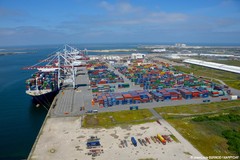- Homepage >
- Press >
- Press releases >
- Details of the press release
News detail
2016 TRAFFIC: DUNKIRK VOLUMES RISE
13rd january 2017

- Record container traffic
- Record modal switchover
Annual traffic for 2016 was over 46.7 MT, an increase of 0.3% compared with 2015.
However, the port of Dunkirk did not escape the effects of the economic climate in 2016, which included the technical shutdowns, for maintenance, of the ArcelorMittal steel works blast furnace No. 4 and the Versalis petrochemicals plant, the permanent closure of SRD (Société de la Raffinerie de Dunkerque) and the delayed opening of the LNG terminal. In addition, grain exports have been penalised by a poor harvest since the summer of 2016.
- General cargoes continued well, with only a slight drop of 1% to a tonnage of 20.3 MT.
Cross-Channel traffic had been exceptional in 2015, increasing by 17% to 16.25 MT. The traffic figures in 2016, with a slight fall of 2%, nonetheless confirmed the 2015 results and reached 16 MT.
The number of trucks and trailers fell 2% to 680,000 freight units. Passenger numbers fell 9% to 2.92 million and tourist vehicles were down 8% at 751,000.
Thanks to the support of leading regional shippers, and the shipping company CMA CGM, container traffic increased significantly, posting a new record of 341,041 TEU (+7%) with 3.15 million tonnes (+4%).
Full containers alone rose by 7% to 221,196 TEU, confirming Dunkirk's position as the first port of call for imports in Europe.
Conventional general cargoes fell by 6% to 1.2 MT, due to manufacturing difficulties in the offshore oil sector (tubes).
Alternative transport modes (waterway and rail) reached 11% in 2016, an increase of 4 points over 2015.
Waterway accounted for just over 20,000 TEU with a modal share rising from 4 to 7%.
Rail represented nearly 10,000 TEU with a modal share rising by 1 point to 4%.
- Bulk solids increased by 1% in 2016 to 22.1 MT despite the challenging economic context.
The ArcelorMittal steel works shut down its largest blast furnace (No. HF4) for 40 days of maintenance at the beginning of 2016. After a difficult start, traffic gradually recovered to reach a level similar to 2015, i.e. 11.5 MT. The ArcelorMittal group has continued to show confidence in Dunkirk as the gateway port for its ore and coking coal.
Coal traffic performed better because of the high volumes transported to the Lorraine region; it was up 6% at 5.4 MT.
Grain made an absolute record during the 2015-2016 campaign (3.05 MT). However, the poor harvest in 2016 meant a volume of 2.8 MT for the year, a drop of 8% compared with 2015, but this was still a good level.
Other bulk solids (slag, cement, scrap metal, sand, aggregate, alumina, petroleum coke, etc) rose 9% to 2.4 MT. The new industrial projects (ECOCEM, ECOPHOS) decided on in 2016 will soon improve these figures.
- Bulk liquids made an average year, up 2% at 4.3 MT, due to the arrival of the first tonnes of LNG.
This sector had to contend with the permanent closure of SRD (Société de la Raffinerie de Dunkerque) and the shutdown of the Versalis plant for maintenance.
Dunkerque LNG carried out three test calls, with a total of 193,000 tonnes, for performance testing prior to handover. The success of these calls meant that commercial production of LNG could begin on 1 January 2017.
Hydrocarbons nevertheless ended the year with a 2% increase at 3.8 MT.
Apart from hydrocarbons, other bulk liquids (oils, chemicals, industrial alcohols, etc) accounted for a total of more than 0.5 MT, an increase of 5%.
- Attached file
- 310_2017_Press_Conference_EN - PDF (184.21 Kb)
- Contact
- Marie-Elizabeth BOGUCKI
Tel: +33 (0)3 28 28 79 11
Portable: +33 (0)6 07 13 33 42
Email: mebogucki@portdedunkerque.fr
Tél : +33 (0)3 28 28 78 78 - Fax :+33 (0)3 28 28 78 77








